The Old Operating Theater Museum and Herb Garret
The Old Operating Theater in London is the museum equivalent of peeling back a bandage on a skinned knee to see what’s underneath. It’s gross and icky but you can’t look away because it’s just so cool.
(I am going to sit back for a minute and hope the rest of this blog post writes itself, because, seriously, I just peaked with that analogy.
Hmm … it seems that my website is not yet self-aware, and requires me to do all the work, so I suppose I’ll just tell you about it.)
Rand had been to The Operating Theater Museum once before, and since he had a meeting with colleagues in the general area, I went by myself. This made the entire experience exponentially more creepy, though on the plus side, I was able to wander around much longer than I could have with Rand “I think three hours in a museum is plenty” Fishkin.
My walk to the museum took me over London Bridge, and was punctuated by some great views:
 –
–
As well as this sign, which made me laugh (because I am apparently 14):
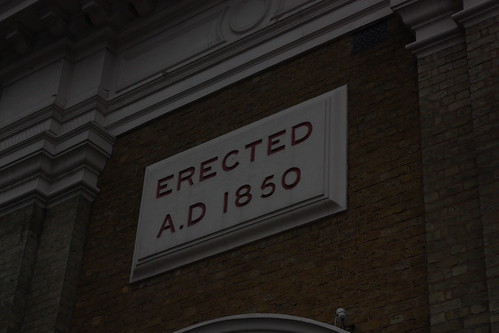
Erected 1850 ... along with HESTER PRYNNE'S LOVER. ZING!
–
I would have likely missed the entrance to the museum all together had it not been for the kindness of one stranger in particular: some kid who kept calling me “love” and who was not, as I had erroneously suspected, trying to steal my purse. He pointed out the easily-missed entrance to me.

Seriously, Britain, must you be so damn demure about EVERYTHING?
–
Though I suppose it’s reasonable that the Operating Theater would be hard to find, given how long it remained hidden. And I’ll sincerely ask that you forgive me, but since I found few sources on this topic, I had to resort to occasionally using Wikipedia to write this post. Yeah, I know. Calm down, you intellectual snob (and yes, darling husband, I am talking to you).
The original St. Thomas’ Hospital was probably built sometime in the 12th century (it was listed as ancient in 1215). It was originally run by monks who attended to the poor, sick, and homeless, as well as unmarried mothers. This example (along with the fat guy from Robin Hood: Prince of Thieves) only serves to solidify my feelings that monks are some of the most awesome members of the church.
In the 17th century the hospital and church were largely rebuilt, and a garret was included at the top of the church, where the apothecary would keep his herbs. The female surgical ward was right next to the garret, and operations took place inside the ward, which was a bit of a downer for the other patients. After all, this was just prior to the invention of antiseptic surgery or the widespread use of anesthetics, so the majority of surgeries performed were amputations. A limb could be be removed in under a minute. A very excruciating, gristly minute. In 1822, part of the garret was converted into an operating theater, where the surgeries could take place away from other patients, but under the watchful eyes of other surgeons as well as medical students.
In 1862, at Florence Nightingale‘s suggestion (her famous nursing school began at St. Thomas’s), the hospital was moved to its present location in Lambeth, and the Operating Theater was closed down, and would remain undiscovered until 1957 by Raymond Russell. After having done some research on the hospital, Russell decided to explore the attic, and found the theater. Which, presumably, is a better find than say, a stack of dad’s old Playboys.
We asked some of our friends how it was possible for something so large to be, well, hidden in plain sight, and they explained that this is a pretty common phenomenon in the U.K. Rooms were often closed up and people just figured it was part of the crawl space or the attic. And seeing how relatively small the museum was, and how it was tucked away into the rafters, it made sense that it could stay uncovered for at least a couple decades. It also makes explains why the entrance to the museum is so narrow and steep.
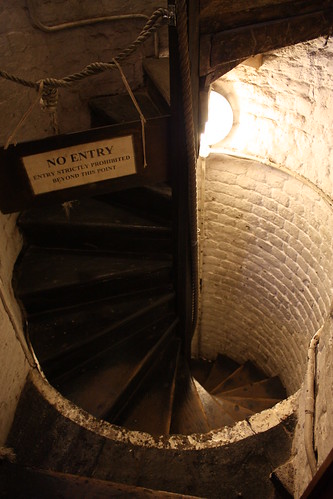
This is looking downward from the top - creepy, no?
The herb garret greets you as you step inside, and there’s a strong smell of herbs (or, as the English would say, herbs, because they like pronouncing silent letters. In all honesty, so do I).
 –
–
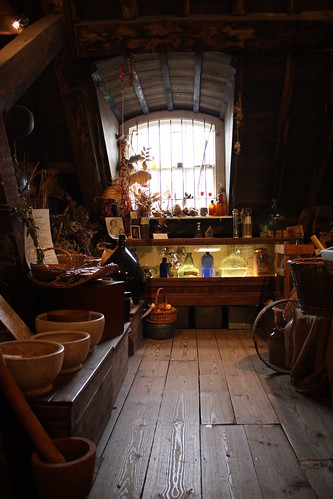 –
–
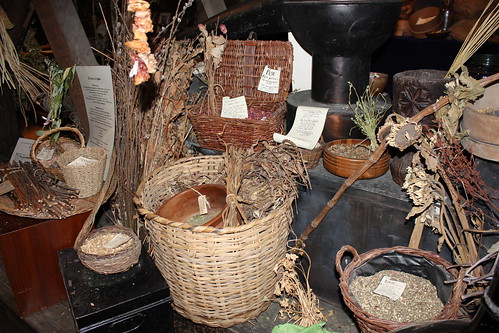
The whole thing was like a hippie pharmacy, and really quite fun. It served as a delightful sorbet to the horror casserole that is the rest of the museum. As you start peeking at some of the medical instruments in the display cases, you realize that we’ve come a long way, baby. Especially when it comes to having said babies. I intentionally didn’t include photos of some of the child-birthing instruments. No need to thank me, ladies.
Instead, let’s look at more pleasant things like SWEET MOTHER OF GOD WHAT IS THAT?
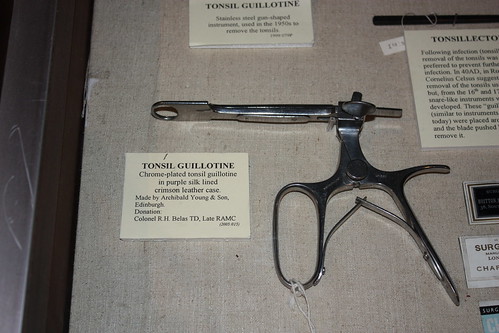
If anyone ever approaches ANY part of me with a guillotine, much less my tonsils, it's going to get ugly.
–
Are you still here, folks? I’m going to warn you guys now, it gets worse. A lot worse. If you decide to skip the rest of this post, I’ll understand. Really. Just go and come back tomorrow, when my entry will be about a day spent in Brighton with my friend Lisa and her lovely family. See you then!
…
Are the wimps gone? Good. Let’s continue. Here’s a nice set of scalpels. Nothing wrong with scalpels, right? I actually own a couple for craft projects. Except these ones are for … um. Your … eyes.
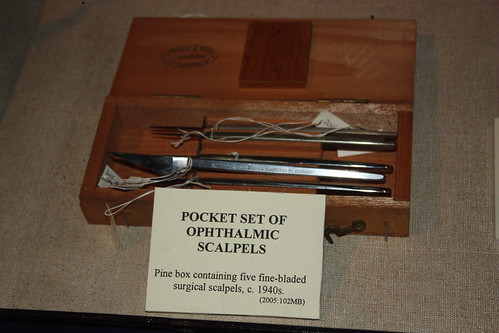
I can't imagine what could be wrong with your eye that could be improved by using these.
–
And here’s a lovely set of amputation saws:
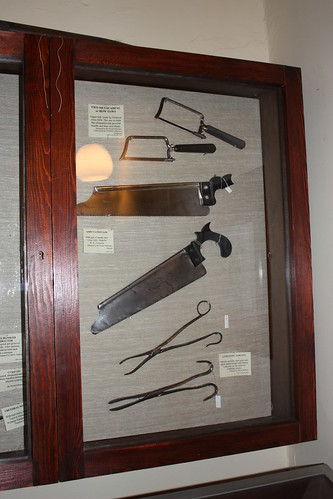
Please, please do not ask what the tongs are for.
–
And just in case the entire scene wasn’t obvious enough for you …
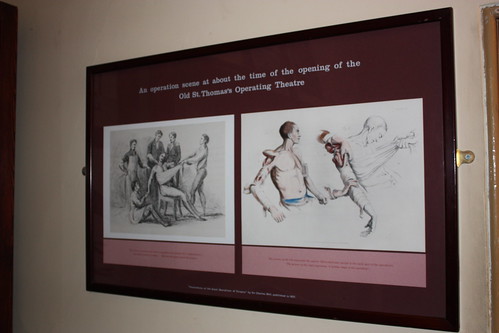
There are diagrams showing you how quick and easy the amputation process can be. Notice I didn't say "painless".
I said it was gristly, right? There was stuff that made my toes curl (specifically, the diagrams pertaining to the removal of toes). After seeing a dozen or so display cases filled with saws, scalpels, bones, preserved brains and lungs, and a handful of “leech bowls”, the operating theater itself isn’t so scary …
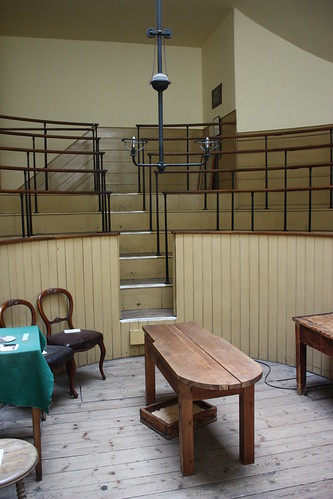
Doesn't seem so bad, right? This is the view from the operating floor.
–
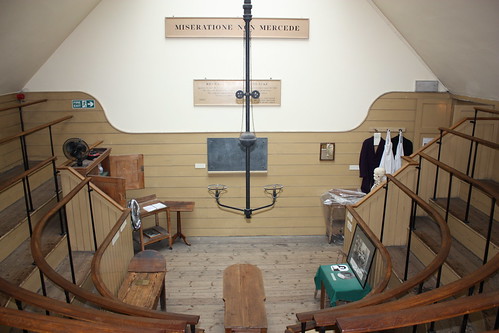
And here's the view from the top of the theater. You can't tell from this photo, but there's a skylight directly overhead.
Of course, that’s before you read some of the descriptions of what happened there. A surgeon, often dressed in a top coat and hat, and wearing a frock coat that was ‘stiff and stinking with pus and blood’, would perform an amputation on a patient, essentially as a last resort. And of course, there’s the operating table itself (from a plaque inside the hospital):
The table was covered with a blanket, over this was a large sheet of brown oil cloth coming well down over the blanket. Beneath the table may be seen a wooden box about 18″ x 12″ x 4″ deep filled with sawdust. The box can be kicked by the surgeon’s foot to any place where most blood is running in little gutters off the oil cloth. As the sawdust becomes unable to absorb anymore and is converted into a bloody porridge, one hears the surgeon call “More sawdust, Holder,” when a fresh box is placed under the table …
I know, I know – “bloody porridge” is probably an image you could do without. Of course, you know me: when things get a little too “real”, I tend to take pictures of myself smiling like a moron, which, depending on context, can be somewhat to wildly inappropriate (and often is). So naturally, when I reached the entrance of the theater, well …
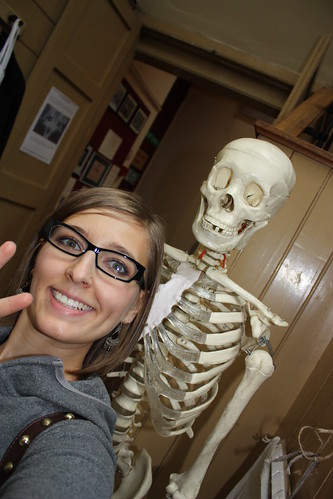
Peace, yo.
I am going straight to hell. But that shouldn’t really surprise you.
As for the hospital, it was closed just prior to the widespread adoption of Joseph Lister‘s antiseptic techniques. Lister was one of the first people to realize that gangrene was actually a form of decay in the human body. He realized the benefits of disinfecting wounds and surgical instruments (and washing your hands before and after surgery), and spread his message across Europe, saving thousands and revolutionizing the medical field. Of course, when I saw his name, I thought, “Oh. The guy for whom Listerine is named.” It’s kind of depressing when your frame of reference is mouthwash.
If you can stomach it, the Old Operating Theater Museum and Herb Garret are definitely worth a visit. But, like swimming, wait at least an hour after eating before diving in. And for the love of Pete, skip having porridge for breakfast.









Leave a Comment